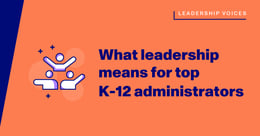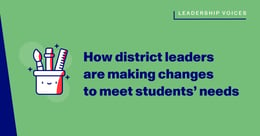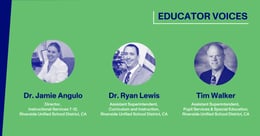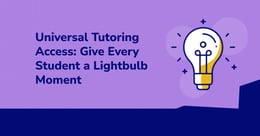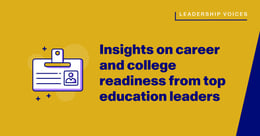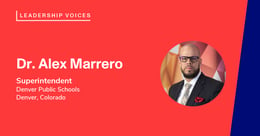This interview, edited for clarity and length, is part of a series with educational leaders to highlight their perspectives on the changing realities of education.

Implementing Structural Change: Dr. Anthony Lewis on Elevating Equity
5 questions with Dr. Anthony Lewis
Dr. Anthony Lewis describes Lawrence, Kansas, as a unique, culturally diverse community with a small-town feel. Situated about 45 minutes west of Kansas City, Missouri, the historic college town proudly hosts Haskell Indian Nations University and the University of Kansas.
As the superintendent of Lawrence Public Schools, Dr. Lewis oversees facilities serving 10,000 students. The district earns high marks for overall academic performance; however, as is the case in many districts throughout the country, achievement gaps persist.
Dr. Lewis spoke with us about his team’s concerted efforts to solve this issue.
How are you coping with the new needs you're seeing in students due to the pandemic? What have you learned, and what are you trying to achieve right now?
At the onset of COVID-19, there were a lot of deficit-oriented terms being used to describe what was happening. We recognized that what we were really seeing was unfinished learning or unrealized potential due to the interruption of COVID.
To grapple with that, we’ve focused on taking care of our students and our staff. Based on current research in the field, we created a theme for the beginning of this school year that used a new interpretation of the three R's: rebuild, rebound, and renew.
We also doubled down on our mental health supports. We were fortunate to have mental health teams already in our schools. To make sure students knew who these people were, we created promo ads and videos reintroducing them to our students.
As educators, we are all concerned about our students. As administrators and leaders in the district, we also have to be concerned about our educators because if they're not well, they can't take care of our students. It’s something we're continuously monitoring.
[READ: Accelerating Readiness and Excellence With Dr. Romules Durant]
Could you tell us about equity efforts in the district?
When I started in 2018, I did a listening and learning tour.
What I was hearing from staff, from boards, and from community members, was, "Look, we've been doing this work awhile and we're not seeing the needle move on many of our equity outcomes." It was a tremendous amount of work, and there was some progress, just not the level of change that we needed.
I also heard that a lot of people viewed this work as optional. I don’t agree with that. We cannot just remove ourselves from the issue. Yes, we want to lean on the experts. At the end of the day, though, I want to be able to build capacity in everybody.
We created an educational equity policy. We partnered with the Midwest and Plains Equity Assistance Center (MAP), to help us develop it. Within that policy, we outlined our definition of educational equity. We wanted to be intentional about saying that the practices, interactions, resources, and budgets involved should be representative of, constructed by, and responsive to the people in the district, including our students and staff members.
These are the four constructs of equity embedded in our policy:
- Access.
- Representation.
- Meaningful participation.
- High outcomes.
Our equity policy spells out that the board, administration, and all of our staff will work together aggressively to eliminate inequitable practices, systems, and structures that can create unfair advantages for some while disadvantaging others.
Again, we want to be intentional with this policy. We want to disrupt and dismantle some of these systems that have been in place for so many years. Our goal with this policy is to get to a place where outcomes will no longer be predicated upon your race, your socioeconomic status, or your marginalized identity.
How do you prioritize equity while facing budget challenges?
Right now, we're dealing with a multimillion-dollar shortfall. We recently gathered together some of our committees—Equity Advisory Council, Parents of Color, District Site Council, Lawrence-Special Education Advisory Committee, the Superintendent's Advisory Council, and the District Student Equity Council. We had about 70 people in the room for this, and we looked at some of the budget-savings proposals that could get us to our goal.
The purpose of the meeting was to take these proposals through our newly created equity impact analysis tool. This diverse group of parents, students, and staff members sat in groups, and they talked about the proposals and how they would impact our four constructs of equity. The idea is that our equity lens will inform budget decisions from the beginning.
Will you tell us about your work around culturally sustainable resource criteria?
Partnering again with the MAP Center, we developed criteria for culturally sustainable resources. Basically, our educators and our curriculum leaders take resources through a comprehensive rubric that contains a series of guiding questions. In a day and age where some school districts are banning books, we use this tool to assess instructional resources and adopted resources, like novels, so we can make sure they are relevant, inclusive, and that they do not harm students.
Our culturally sustainable resource tool asks questions like, “Who's benefiting from this? Are there multiple perspectives within this book? Who's being represented in a positive or negative way?” Many of our teachers have been really pleased with the tool because it centers the work on equity and focuses on making sure that our students see themselves in the curriculum.
It's one of those things: when we know better, we do better. It really has been a learning experience.
[READ: TALAS Executive Director on Advancing Latino Leaders and Learners in Texas]
How do discipline criteria impact equity?
When we think about the disparities that exist in our schools, we have to confront the disproportionate number of students of color who may be suspended or face other disciplinary measures. I can share a little bit about how we are addressing this.
Similar to what you may see in the national data, we found that students of color were more likely than their white classmates to be suspended with subjective citations. We've removed a lot of subjective language from our discipline matrices and practices—terms like disobedience, disrespect, and disruptive behavior.
We've also been intentional about training the community members in our high schools and middle schools to use restorative practices. We'll introduce these tools to our elementary schools this coming school year.
With all the training in the world, if we don't disrupt or dismantle the system that perpetuates inequities, we’re not going to get anywhere. We're disrupting that system and putting things in place that will outlive all of us. Long after I'm gone, long after the board changes, these systems, this policy, will still be in place. That will benefit generations to come.

